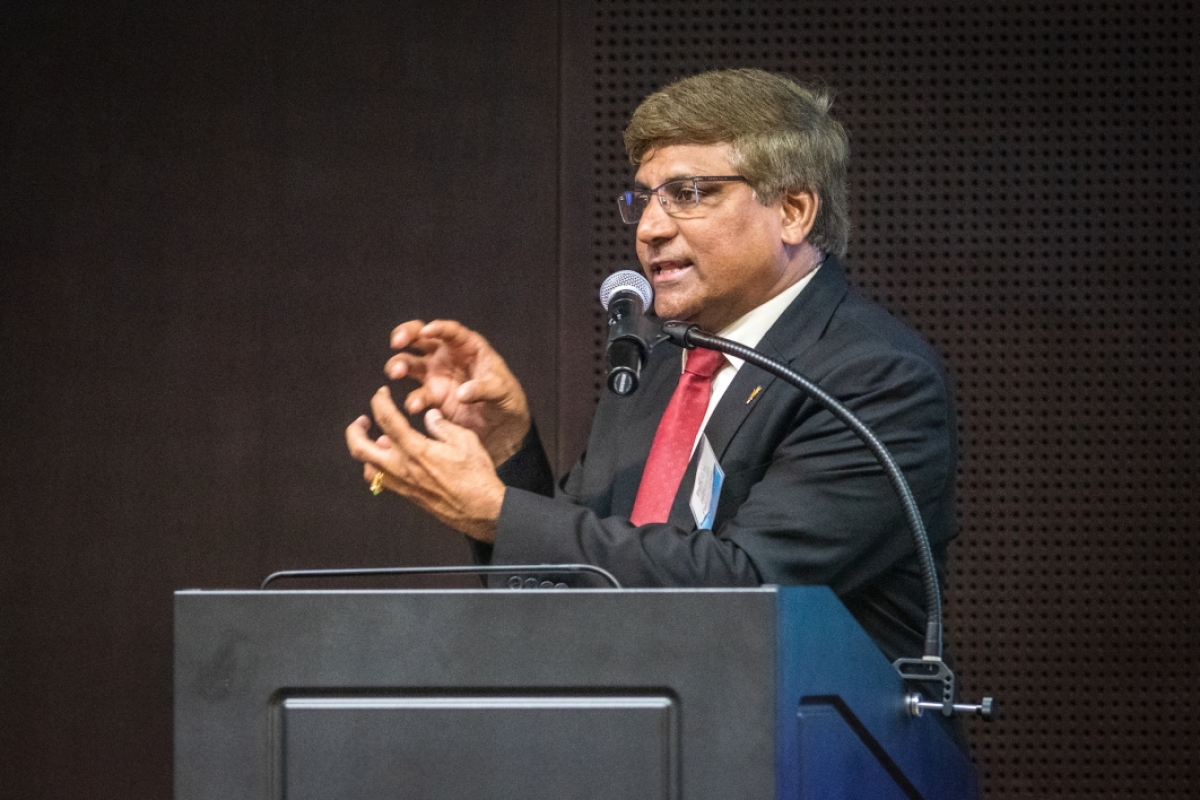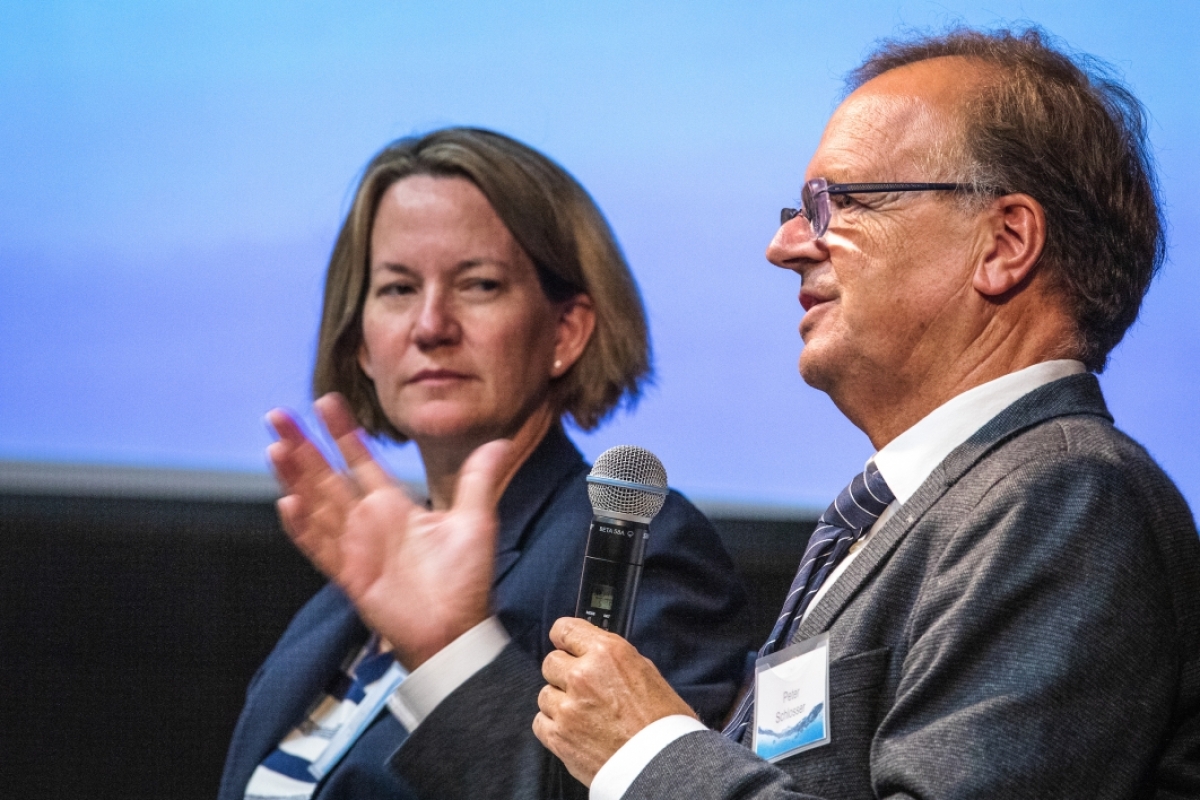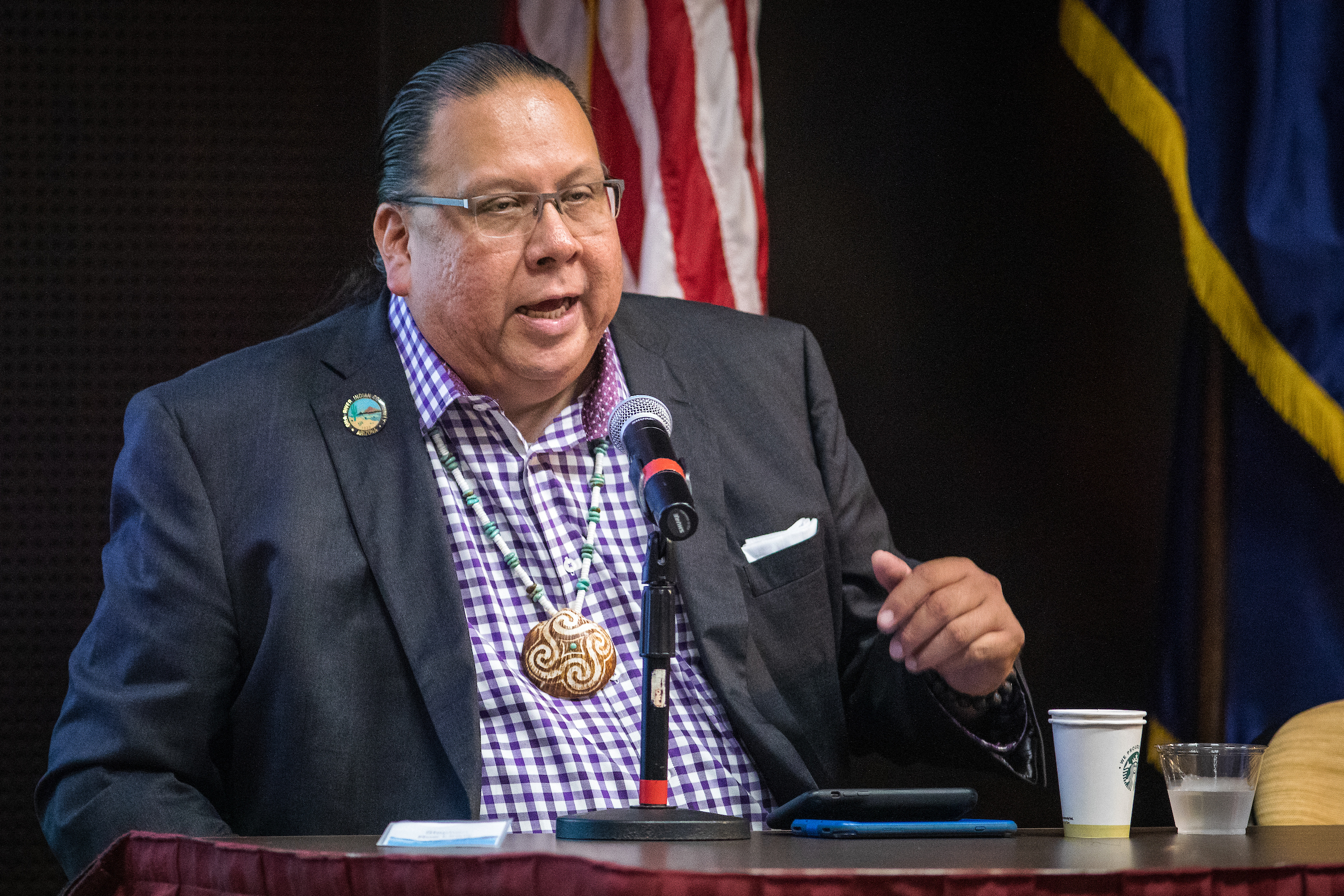Arizona is facing a colossal challenge in managing its water supply — especially with the uncertainty of climate change effects. But several experts at an Arizona State University conference said there are reasons to be optimistic.
“We can’t go from denying there are challenges to being fatalistic,” said Peter Schlosser, vice president and vice provost of the Global Futures Laboratory at ASU.
“That would be the wrong response. We have to trust we have the capacity to find solutions.”
Many of those potential solutions, as well as the scope of the problems, were discussed by the state’s top policymakers, scientists and influencers on Monday at “Revolutionizing Arizona’s Water Future,” the 2019 Congressional Conference sponsored by ASU's Office of Knowledge Enterprise Development and Office of Government and Community Engagement.
“Today’s conference focused on the need to work in collective, collaborative and innovative fashion to proactively address Arizona’s short and long-term water futures needs,” said Sethuraman Panchanathan, executive vice president of Knowledge Enterprise and chief research and innovation officer at ASU.
“There was a genuine consensus among participants that we must find creative, entrepreneurial approaches to solving what amounts to a global grand challenge – that of a safe, reliable, water supply.
“There’s a recognition that we can’t look back 10 years from now and say, ‘We should have brought together the right people, partners and teams to find the right solutions a long time ago.’ We’re doing it now,” Panchanathan said.
Schlosser put the water problem in context.
“In the water world, the main challenges are twofold: One is we do not have enough water going into the future to fulfill our needs, so there’s a problem in quantity,” he said.
“If you look at satellite pictures over time, it shows we’re overusing groundwater. It’s a worldwide phenomenon and we know these waters we are destroying were formed millions of years ago, so we will not be able to replenish them at the pace we are destroying.”
The other problem is quality.
“We are soaking our planet with chemicals and many find their way into the water,” he said. “If you go to the deepest ocean, you’ll find chlorofluorocarbons. Just recently there was a report that microplastics are in any kind of snow sample you take from the Arctic.”
Technology is one answer.
“You can look at some of the accomplishments in the reuse of water, and in the decrease of use of water in development,” he said. “But we are sometimes looking at the technosphere as the ultimate way forward but we have to mobilize society will so new solutions are embraced.
“So people are looking at changing the way they live but not by sacrificing too much, just different. Life has always changed.”
Here are the main takeaways from the conference:
There’s good and bad news in Arizona
Sarah Porter, director of the Kyl Center for Water Policy at ASU
“An important fact for us all to keep in mind is that currently, statewide demand is slightly lower than it was in the mid-1950s. We’ve grown our economy 17 or 18 times and our population eight times since the mid-1950s and we’re using slightly less water.”
Ted Cooke, general manager of the Central Arizona Project
“We think of water augmentation as a completely new supply, like ocean desalination or cloud seeding. And we’re working on that so we don’t get caught by surprise when things are dire. But there’s a lot of efficiencies that can be gained with the supply we have. We have magnificent infrastructure in this state, the Central Arizona Project and the Salt River Project are two of them. A little bit of federal funding could interconnect them. We have millions of acre feet of water that’s been put underground for future use and we don’t have the recovery infrastructure to use all of it.”
11 tribes have not reached a water claim settlement
Dennis Patch, chairman of the Colorado River Indian Tribes
“We’ve seen several rivers in Arizona go dry and that’s our first priority. We’ve always lived on the river and we’ve always been farmers. We want to develop our full water rights and we also want federal legislation that permits us to lease water to Arizona. Right now we only have the right to store water in Lake Mead.
“My parents and grandparents talked about the salmon that used to come up the Colorado River, but I was born after the dams. Our name for ourselves is ‘people by the water.’"
Stephen Roe Lewis, governor of the Gila River Indian Community
“First, we want to be sure our current and future farmers have enough water, and second we want to restore portions of the Gila River on our land. When our Gila River was diverted over 100 years ago, that literally pushed us to the brink of extinction. We almost died out as a people but we didn’t because we persevered. So holding water in the highest regard is one of our most important value systems.
“Tribes need to be at the table when important water decisions are being made. When you look at this Drought Contingency Plan, tribes weren’t there at the beginning. All the players, including SRPSalt River Project, one of Arizona's largest utilities., knew that potential shortages were happening around 2013, and we were not even told by federal authorities until 2015 and we didn’t get invited as a community until 2016.”
Stephen Roe Lewis, governor of the Gila River Indian Community, said that restoring the Gila River is one of the main water priorities for his tribe. Photo by Charlie Leight/ASU Now
Jane Russell-Winiecki, chairwoman of the Yavapai Apache Tribe
“We’ve been working on this since the middle of the 1980s. You can imagine the hours and the financial burden it’s cost us as well as the state and federal governments. We’re on the Verde River, which is one of the few perennially running rivers left in Arizona. We don’t want a paper settlement. We want wet water. We’re trying to protect the river, protect us and the neighboring communities so you get wet water down into this area.”
Sarah Porter, director of the Kyle Center for Water Policy at ASU
“The reality is that many communities in Arizona are growing on supplies of water that are in dispute, so they don’t have certainty about their water.”
Forest management is crucial to the water supply
Chuck Podolak, director of water rights and contracts for SRP
“Our ponderosa forests are too dense and they’re the headwaters of the water supplies. It’s a matter of getting the U.S. Forest Service to work with the contractors to get it done. Indian water rights and forest treatment are two things that are unacceptably slow. There are way too many trees in our forests and getting them out is one of the highest priorities for in-state water supplies.”
Clint Chandler, deputy director of the Arizona Department of Water Resources
“I was immersed in this issue when I was working with Senators (Jon) Kyl and (Jeff) Flake. We were frustrated when we were trying to encourage the U.S. Forest Service to work with White Mountain Apache Forest Industries, because it’s essential to get these acres cleared, but they were letting these companies wither."
Ted Cooke, general manager, Central Arizona Project
“Are we on the verge of curtailing access to public lands because we have to address the danger of having people there? Our regional lake is Lake Pleasant. When there’s a fire, lots of junk washes into that lake — debris from the fires, dirt and ashes."
Abe Springer, professor of hydrogeology at Northern Arizona University
“We recently did a survey of Phoenix residents and they are significantly willing to pay for forest restoration. There’s been a change in thinking — that our watersheds are infrastructure that needs planning, like pipes. This was after the Schultz Fire in 2010. In the general election that year, we put a bond where the city of Flagstaff invested $10 million in the watershed."
Business and industry have to be involved
Todd Brady, director of global affairs and sustainability at Intel Corp
“Water is critical to making semiconductors. We broke ground on our Ocotillo facility, one of the largest semiconductor manufacturing plants in the world, and we made a partnership with the city of Chandler to build a reverse-osmosis plant where our wastewater went to be treated to be reused by the city or put into the aquifer.
“More recently we set a goal to restore 100% of our water by 2025. Our idea was for every gallon of water we took in, would we put a gallon back. We’re a bunch of engineers and the only way to get to that 100% was to do partnerships across the state of Arizona to replenish the watershed.”
Paul Westerhoff, Fulton Chair of Environmental Engineering at ASU
“We commissioned a survey of a variety of industrial water users in Maricopa County and … looked at hospitals, hospitality, breweries, small businesses. Over 70% identified water as critical to their business but they didn’t really understand the true cost to what they were spending beyond their water bill. They didn’t feel that industry has a common place to go to talk about concerns. We can start getting these industries together to talk about best practices around water.”
John Kmiec, deputy director at Tucson Water
“In southern Arizona, it’s a changing scene. We had water reclamation to support the golf industry. What we’ve seen in last 10 years is the golf industry has regressed. Now we have all this capital investment to move communities’ non-potable water to all four corners to serve the irrigation needs of a once prosperous industry. So one thing Tucson is doing is thinking how we entice other industries to come in to reuse the water and the existing infrastructure.”
Water and energy are closely linked
Benjamin Ruddell, director of the School of Informatics, Computing and Cyber Systems at Northern Arizona University
“The last 40 years of research and development have made it possible to generate energy in ways that don’t use much water. We’ve moved from coal-fired and nuclear plants that use huge amounts of water into bio-fueled power systems. Solar and wind don’t use much water if they’re done properly. Those areas are far more valuable in Arizona than in other places because we’re so water challenged.”
Kim Ogden, director of the Institute for Energy Solutions at the University of Arizona
“It takes a lot of energy to purify water. We’re using very concentrated solar systems to make purified water and energy at the same time. Data systems have a lot of wasted heat. How do we take that wasted heat to do something like purify water? Those are examples where we integrate energy and water.”
Arizona’s congressional delegation can ease the way
U.S. Sen. Martha McSally
“Not every issue is a federal issue. Arizona did a lot of the heavy lifting with the drought contingency plan … and that was critical because otherwise we would have had a heavy-handed approach coming from the feds. As many issues come to me that I’m asked to solve, I ask, ‘Does it literally take an act of Congress to fix?’ And in this case, it did, after all the hard work at the state level.
“We introduced the legislation and six days later we passed it out of the house and senate and that’s record time in Washington, D.C. If you turn on cable news you would think that kind of bipartisan work doesn’t happen in Washington, D.C., but it happens all the time, especially on issues related to water.
“One issue I heard about in Yuma is that some of our water infrastructure is more than 50 years old. In other places in the world, if you make a long-term investment in something, you can pay it back over many years. But because the way this works with federal policy, the water districts … literally have to recoup those costs that year. The only way they can do that is to charge their users more for water in that year. That’s not a good model.
“Sen. Sinema and I introduced this bill together. This legislation provides more flexibility in a new funding mechanism for investments to be made up front and paid over time with interest and not passed on to the water users in just one year.
“Every time I hear anyone talking about a way forward on the bipartisan infrastructure legislation, I’m always jumping up and down, saying ‘What about water infrastructure?’ The challenges they have in New Jersey and Massachusetts are not the same challenges we have here in the West related to our water."
Arizona citizens are key to moving forward
Sarah Porter, director of the Kyl Center for Water Policy at ASU
“There’s still a lot of give in the system. I would walk though my Arcadia neighborhood, looking at the flood irrigation and seeing the citrus trees think, ‘What a waste of water.’ But I’ve come to see places like my neighborhood as the future. All that is done with renewable supplies. Maybe someday, people in my neighborhood will take the opportunity to use less water so it can be used elsewhere and they will be rewarded for that.”
Paul Westerhoff, Fulton Chair of Environmental Engineering
“It’s figuring out what safe water is and this bigger idea of how we make safe water — not from a scientific epidemiologic perspective, but from people you talk to every day. Would you drink treated waste water?”
Top image: U.S. Sen. Martha McSally attended the "Revolutionizing Arizona's Water Future" Congressional Conference on Monday at the Memorial Union at ASU. She told the crowd that water legislation is frequently a bipartisan effort in Washington, D.C. Photo by Charlie Leight/ASU Now
More Law, journalism and politics
Can elections results be counted quickly yet reliably?
Election results that are released as quickly as the public demands but are reliable enough to earn wide acceptance may not always be possible.At least that's what a bipartisan panel of elections…
Spring break trip to Hawaiʻi provides insight into Indigenous law
A group of Arizona State University law students spent a week in Hawaiʻi for spring break. And while they did take in some of the sites, sounds and tastes of the tropical destination, the trip…

LA journalists and officials gather to connect and salute fire coverage
Recognition of Los Angeles-area media coverage of the region’s January wildfires was the primary message as hundreds gathered at ASU California Center Broadway for an annual convening of journalists…






